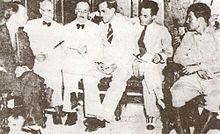José Irisarri
José M. Irisarri | |
|---|---|
| Minister of Public Works and Agriculture[1] | |
| In office September 5, 1933 – September 10, 1933 | |
| President | Executive Commission of the Provisional Government of Cuba |
| Constituency | Republic of Cuba |
| Minister of Finance | |
| In office July 18, 1942 – 1943 | |
| President | Fulgencio Batista |
| Constituency | Republic of Cuba |
| Minister of Finance | |
| In office October 10, 1944 – October 10, 1948 | |
| President | Ramón Grau |
| Constituency | Republic of Cuba |
| Personal details | |
| Born | José Miguel Irisarri y Gamio[2] August 31, 1895 Abreus, Santa Clara Province (now Cienfuegos Province), Captaincy General of Cuba, Spanish Empire |
| Died | 1968 |
| Nationality | |
| Political party | Partido Auténtico |
| Children | 3 |
José Miguel Irisarri y Gamio (born 1895 - 1968) was a lawyer and a member of the Pentarchy of 1933.
Biography
[edit]Early life
[edit]José Miguel Irisarri y Gamio was born in Abreus, Santa Clara Province (now Cienfuegos Province), Spanish Cuba, on August 31, 1895. He completed his early studies in Spain.[3]
From 1923 to 1924, he participated in the Veterans' And Patriots' Movement led by Carlos García Vélez in opposition to the Alfredo Zayas y Alfonso administration.[4][5]
He was educated as a lawyer. On January 17, 1930, he participated in a debate at the Havana Bar Association.[6]
Politics
[edit]Irisarri was an early member of the Directorio Estudiantil Universitario (English: Directorate of University Students) established at the University of Havana. For rejecting the presidency of a Gerardo Machado electoral district, he was imprisoned for two years in Castillo del Príncipe on the Isle of Pines. He went into exile in May 1931 and returned to Cuba amid the Carlos Manuel de Céspedes y Quesada presidency.[7]
During this period, Sumner Welles reported that Irisarri was a law partner of Cuban President Mario García Menocal's son-in-law, Eugenio Sardina.[8]
Pentarchy of 1933
[edit]
In September 1933, Irisarri was a part of the brief provisional government of Cuba, known as the Pentarchy of 1933, which included Porfirio Franca, Guillermo Portela, Ramón Grau, and Sergio Carbó.[9] The short-lived Pentarchy lasted for 5 days, before being replaced by the first Grau administration.[10] Irisarri remained closely connected to the Cuban political party, Partido Auténtico, founded in 1934.
In the early 1940s, Irisarri headed Cuba's Import and Export Agency.[11]
On July 18, 1942, President Fulgencio Batista issued a decree appointing Dr. Irisarri as Minister of Finance.[12] By 1943, he left his position by submitting his resignation.[13]
In 1943, while in Havana, he consulted with Frank Southard of the Navy Department and E.M. Bernstein of the Treasury Department about creating a Cuban central bank.[14]
When Ramón Grau assumed the presidency in 1944 until 1948, Jose Irisarri served in his cabinet as Minister of Finance.[15] In 1948, Grau's successor, Carlos Prío Socarrás became president, establishing the Auténtico government. On December 20, 1950, President Carlos Prío signed a law to establish the Agricultural and Industrial Development Bank. In January 1951, Jose Irissari was appointed vice president of the bank's Agricultural Division, headquartered in Havana.[16][17] After Fulgencio Batista's 1952 Cuban coup d'état deposed President Carlos Prío Socarrás, Irisarri immediately resigned from the position he held.[18][19]
He kept practicing law as an attorney and was listed in 1956 with an office in the Almendares neighborhood of Havana.[20]
Death
[edit]José Miguel Irisarri y Gamio died in 1968.
References
[edit]- ^ "Cabinet Positions Apportioned - Press Censorship Not Planned - Newspapers.com™". newspapers.com. Retrieved 2024-05-17.
- ^ "Cuba Heads of State". latinamericanstudies.org. Retrieved 2024-05-17.
- ^ Cao Mendiguren, A. (2008). La verdadera república de Cuba. United States: Ediciones Universal.
- ^ Whitney, R. (2017). State and Revolution in Cuba: Mass Mobilization and Political Change, 1920-1940. United States: University of North Carolina Press.
- ^ A Companion to Modern and Contemporary Latin American and Latina/o Art. (2021). United States: Wiley.
- ^ Revista de la Habana. (1930). Cuba: (n.p.).
- ^ "Cuban Rulers Biography of Wide Interest - Newspapers.com™". newspapers.com. Retrieved 2024-05-17.
- ^ "The Ambassador in Cuba (Welles) to the Secretary of State | Foreign Relations of the United States, Diplomatic Papers, 1933, The American Republics, Volume V". history.state.gov. Retrieved 2024-05-17.
- ^ Fermoselle, R. (1987). The Evolution of the Cuban Military, 1492-1986. United States: Ediciones Universal.
- ^ Alvarez, J. (2009). Frank Pais: Architect of Cuba's Betrayed Revolution. United States: Universal-Publishers.
- ^ Comprehensive Export Control Schedule. (1942). United States: Administrator of Export Control.
- ^ Boletín oficial de la Secretaría de Estado de la República de Cuba. (1942). Cuba: Lib. e Imp. "La Moderna Poesia".
- ^ Boletín oficial de la Secretaría de Estado de la República de Cuba. (1943). Cuba: Lib. e Imp. "La Moderna Poesia".
- ^ The American Republics. (1965). United States: U.S. Government Printing Office.
- ^ Fermoselle, R. (1987). The Evolution of the Cuban Military, 1492-1986. United States: Ediciones Universal.
- ^ Foreign Agriculture. (1952). United States: U.S. Department of Agriculture, Bureau of Agricultural Economics.
- ^ The Burroughs Clearing House. (1950). United States: Burroughs Corporation.
- ^ Cavendish, Richard (March 2002). "General Batista Returns to Power in Cuba". History Today. Vol. 52, no. 3. London: History Today Ltd. Retrieved August 26, 2024.
- ^ Marel García, G., García-Pérez, G. M. (1998). Insurrection & Revolution: Armed Struggle in Cuba, 1952-1959. United Kingdom: L. Rienner Publishers.
- ^ Guía social de La Habana. (1956). (n.p.): (n.p.).
